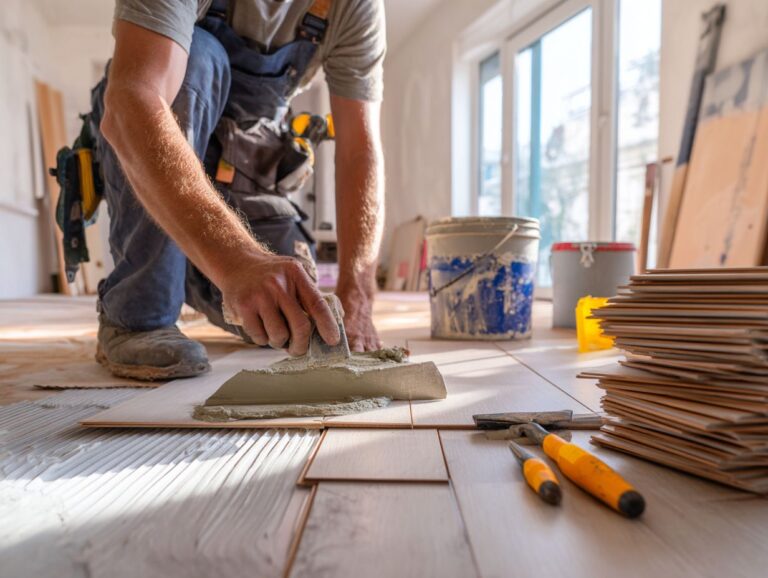Flooring Financing Options – Loans, Credit, Payment Plans
Contents
- Introduction to Flooring Financing Options
- Flooring Industry and Financing Statistics 2024
- Types of Flooring Financing
- Understanding Loans for Flooring
- Credit Options for Flooring Purchases
- Payment Plans for Flooring Installation
- Comparing Financing Options
- Frequently Asked Questions
- What are the different types of financing options available for flooring?
- How do flooring loans work?
- Can I use a credit card to finance flooring?
- What is a payment plan for flooring?
- What should I consider when choosing a financing option for flooring?
- Is it possible to get financing for flooring with bad credit?
Introduction to Flooring Financing Options

Key Takeaways:
Importance of Financing for Flooring Projects
Financing plays a big role in how homeowners make decisions; it can turn large costs into affordable monthly payments.
For instance, many homeowners allocate roughly 10% of their total housing budget to upgrades, which often means financing options become necessary to avoid fronting large sums.
Popular methods include:
- Personal loans, which average around 6-36% interest
- Credit cards, offering flexibility but potentially higher rates
Utilizing tools like a home equity line of credit (HELOC) can also provide lower interest rates.
Take advantage of online calculators to determine monthly payments and compare these options to find the most affordable solution for your flooring upgrade.
Overview of Available Financing Options
Homeowners have access to various financing options, including personal loans, credit cards, and special retailer financing promotions.
Personal loans come with set interest rates and regular monthly payments, which simplifies planning your finances. They often require good credit and can take time to secure.
Credit cards provide flexibility and sometimes come with rewards, but high-interest rates could lead to debt if not paid off quickly.
Meanwhile, special retailer financing promotions, such as no-interest plans, can make large purchases manageable, but they may include deferred interest clauses that could surprise you later.
Evaluating these options can help determine the best fit for your flooring project.
Flooring Industry and Financing Statistics 2024
Flooring Industry and Financing Statistics 2024
Flooring Industry Overview: Industry Sales and Volume
Flooring Industry Overview: Category Performance (2024)
Consumer Financing Impact: Consumer Financing Benefits
Consumer Financing Impact: Interest Rates
Consumer Financing Impact: Consumer Confidence and Housing
The Flooring Industry and Financing Statistics 2024 Explains the present state and challenges in the flooring industry, along with the impact of consumer financing on this sector. The data highlights a noticeable decline in both sales and volume across various categories, reflecting broader economic pressures and shifts in consumer behavior.
Flooring Industry Overview data indicates a 4.6% decline in total industry sales, dropping from $25.116 billion in 2023 to $23.955 billion in 2024. Similarly, the volume fell by 3.5%, from 17,835 units to 17,206 units, suggesting a contraction in market activity perhaps due to reduced consumer spending or economic factors.
- Category Performance (2024): The decline in sales and volume varies by category. Carpet sales and volume declined by 4.1% and 4.2% respectively, indicating a steady drop in demand. Resilient flooring showed a modest decline, with sales down 2.3% and volume down 0.5%, possibly retaining demand due to its durability and versatility. Hardwood faced significant declines with 9.0% in sales and 10.7% in volume, perhaps due to its higher cost and luxury positioning during economic downturns. Both Laminate and Ceramic experienced a 7.5% decline in sales, with laminate volume declining by 4.8% and ceramic by 6.3%, indicating decreased renovation and construction activities.
The Consumer Financing Impact segment reveals how financing options influence purchasing behaviors. The average financed ticket of $6,800 contrasts with the $3,500 average credit card ticket, suggesting that financing options encourage larger purchases, possibly due to lower up-front costs and manageable payment plans.
- Interest Rates: A drop in the average inflation rate from 3.4% in 2023 to 2.9% in 2024 may provide slight relief to consumers and businesses, although higher interest rates from 2022-2024 could still impact borrowing costs and spending power.
- Consumer Confidence and Housing: A 30% decline in US existing home sales highlights a challenging real estate market, potentially affecting flooring sales as fewer homes change ownership or are renovated.
The Flooring Industry and Financing Statistics 2024 highlights significant challenges in the flooring market, driven by economic factors, consumer behavior, and housing market conditions. Knowing these factors is important for businesses that want to plan well and use financing choices to increase sales in a shrinking market.
Types of Flooring Financing

Knowing the various flooring financing options is important for homeowners to pick the one that suits their budget best.
Personal Loans
Personal loans, typically ranging from $1,000 to $50,000, can provide homeowners with the necessary funds for flooring projects at competitive interest rates.
Interest rates vary widely, generally between 5% and 36%. Loan terms usually span from 2 to 7 years.
When looking for a loan, think about choosing well-known lenders such as:
- Acorn Finance
- SoFi
- Marcus by Goldman Sachs
To improve your chances of approval, get prequalified by providing basic personal and financial information online. You can check potential rates and terms without impacting your credit score, allowing you to consider various options before deciding.
Home Equity Loans
Home equity loans let homeowners borrow against their property’s worth. These loans usually provide more money at lower interest rates than other types of loans.
To determine equity, assess your home’s market value and subtract any outstanding mortgage balance.
Typical loan terms range from 5 to 30 years, with interest rates generally falling between 3% and 8%. Borrowers must be cautious, as failure to repay could lead to foreclosure.
Before committing, compare lenders and consider getting pre-approved to understand your options clearly. Make sure you can handle monthly payments comfortably in addition to your other financial responsibilities to prevent possible problems.
Credit Cards
Using credit cards for flooring purchases can provide immediate financing with the added benefit of promotional offers like 0% APR for 12-18 months.
It’s important to think about the effects over time. For instance, if you don’t pay off the balance before the promotional period ends, you could face high interest rates, often above 20%.
Big credit card companies such as Chase, Discover, and American Express often offer these deals, making them a dependable option for purchasing new flooring. Make sure to check for any fees related to late payments or cash advances, as these can cancel out the advantages of starting financing.
Store Financing Options
Many flooring retailers offer their own financing solutions, often with promotional offers designed to entice customers to make larger purchases.
For instance, Shaw Floors provides financing through options like no-interest plans for a set period when purchases exceed a certain amount. Similarly, Synchrony Bank partners with retailers to offer flexible monthly payment plans.
To qualify, shoppers typically need a good credit score and may be required to submit an application at the time of purchase. These financing options make high-quality flooring easier to afford and help customers plan their spending on home improvements.
Understanding Loans for Flooring
Homeowners need to know about loans to fund their flooring projects. This involves knowing the difference between loans that need collateral and those that do not.
Secured vs. Unsecured Loans
Secured loans, backed by collateral such as home equity, often feature lower interest rates compared to unsecured loans that rely solely on creditworthiness.
Secured loans are ideal for extensive flooring projects, as they typically offer larger sums for longer terms. For example, a homeowner might use a home equity loan to fund a $15,000 hardwood floor renovation, enjoying interest rates around 4%.
In contrast, unsecured loans, like personal loans, might be suitable for smaller jobs-$5,000 to install tile-despite their higher interest rates, approximately 10-15%. This makes unsecured loans riskier, so it’s critical to assess your budget and repayment capability before choosing the right option.
Loan Terms and Interest Rates
Knowing the details of loan terms and interest rates can greatly impact the overall expense of financing for flooring.
Typically, flooring financing offers terms ranging from 1 to 10 years, with shorter terms often featuring lower interest rates.
For instance, a 3-year loan might offer a rate of 5% while a 10-year loan could be 7%. These rates are influenced by factors like your credit score-higher scores generally yield better rates.
Lender policies and the type of loan, such as secured or unsecured, can affect terms as well. Always compare multiple offers to find the best deal that aligns with your budget and flooring needs.
Application Process for Flooring Loans
You can make applying for flooring loans easier by following clear steps. Start by checking your credit score and getting prequalified with lenders.
Begin by gathering necessary documentation, such as proof of income, tax returns, and details of your existing debts.
Knowing what lenders require is important; some lenders might focus on a credit score of at least 620, while others provide better rates for scores higher than 700.
After compiling your documents, apply for prequalification online through lenders like LightStream or Wells Fargo, which provide quick feedback on potential financing options.
Although this initial step could take a few hours, it significantly improves your likelihood of securing favorable loan terms.
Credit Options for Flooring Purchases

Looking into credit choices for buying flooring helps homeowners handle expenses and make the most of special deals from different stores.
Using Credit Cards for Flooring Expenses
Credit cards can be a useful option for covering flooring costs, especially when using rewards and special financing deals.
To maximize benefits when using credit cards for flooring purchases, consider these strategies.
- Look for cards with a 0% APR for a set time, which lets you pay off your balance without any interest.
- For instance, the Chase Freedom card offers cashback rewards on home improvement purchases.
- Try to pay more than the minimum amount each month to prevent interest charges after the promotional period.
- Keep track of your spending through mobile apps like Mint or YNAB for better budget management, ensuring you stay within your financial limits.
Benefits of Using Store Credit
Store credit options from flooring retailers can offer benefits like delayed interest charges and flexible payment plans for particular purchases.
A lot of stores provide special financing options that let you pay over a few months without interest if you settle the full amount by the deadline.
For instance, check for offers like ‘No Interest for 12 Months’ or ‘6 Months Special Financing’ available at stores like Home Depot or Lowe’s.
To get the most out of these options, make sure you know the terms and use them mainly for bigger expenses, such as buying new carpets or installing hardwood floors. This approach helps you handle your expenses wisely and make significant upgrades to your house.
Impact of Credit Score on Financing
A homeowner’s credit score is an important factor that affects financing choices, directly impacting interest rates and the likelihood of getting a loan.
Lenders assess credit scores through factors like payment history, credit utilization, and length of credit history. For example, paying your bills on time can increase your score, while using a lot of your available credit can decrease it significantly.
To improve your score, consider strategies such as:
- Reducing credit card balances
- Disputing inaccuracies on your credit report
- Becoming an authorized user on a responsible person’s credit card
By following these steps, you can make your credit history better and qualify for financing with lower interest rates and favorable loan terms.
Payment Plans for Flooring Installation
Payment plans for flooring installation can help homeowners afford the costs without overwhelming their finances.
Types of Payment Plans Offered
Retailers often offer different payment options, such as paying later, installment plans, or lease-to-own choices.
Deferred payment plans allow customers to purchase flooring without immediate payment, often requiring payment after a promotional period. For example, a retailer like Home Depot may offer a six-month no-interest plan.
Installment plans break the total cost into manageable monthly payments, which can be beneficial for budget-conscious shoppers. Lease-to-own options provide the flexibility of rental payments that can be applied toward ownership.
While these plans help reduce financial strain, they may result in higher overall costs due to interest or fees, so compare each option carefully.
How to Choose the Right Payment Plan
Choosing the right payment plan requires a careful assessment of your budget, flooring costs, and long-term financial implications.
Start by evaluating your income and essential expenses to determine how much you can allocate towards monthly payments.
Compare the payment terms of different plans-look for interest rates, hidden fees, and penalties for early repayment. A 0% interest plan might look appealing, but check the details to confirm it’s not one where interest is added later.
Use budgeting tools like Mint or You Need a Budget (YNAB) to see your financial obligations and come up with a plan that works well with your budget.
Pros and Cons of Payment Plans
Payment plans can offer both advantages and disadvantages, such as improved cash flow versus potential long-term debt obligations.
For homeowners considering financing options for flooring installation, it’s essential to weigh the benefits and drawbacks.
On the positive side, payment plans can help manage initial costs, allowing for immediate installation-ideal for urgent repairs. Long-term commitments may result in higher overall costs due to interest. For example, a $3,000 installation with a 12-month plan at 10% interest totals about $3,300.
Some retailers provide zero-interest plans for a short period, so it’s important to read the details before agreeing.
Comparing Financing Options
Exploring different financing options for flooring helps homeowners decide what matches their budget and project needs.
Cost Analysis of Different Financing Methods

Looking at the expenses of various financing options shows major variations in overall costs, monthly payments, and long-term financial effects.
When comparing financing methods like personal loans, credit cards, and home equity lines of credit, consider key attributes such as interest rates, fees, and repayment terms.
Personal loans typically offer fixed rates around 6-36%, while credit cards may charge variable rates of 15-25%. For home equity lines, rates usually start lower but can fluctuate.
Personal loans often have lower upfront costs but require a solid credit score, whereas credit cards might have higher fees but offer flexibility. Carefully assess your credit profile to choose the most financially viable option.
Long-term vs. Short-term Financing Considerations
Knowing how long-term and short-term financing differ is important for homeowners because it impacts costs and payment plans.
Long-term financing typically involves lower monthly payments spread over 15 to 30 years, resulting in a smaller immediate financial burden but higher total interest paid.
Conversely, short-term financing, often spanning 5 to 10 years, leads to larger monthly payments but reduces the total interest significantly.
For instance, a $200,000 loan at 4% interest over 30 years would cost about $143,000 in interest, while a 10-year loan at the same rate would incur roughly $30,000.
Evaluate your budget and financial goals to determine the best option.
Final Thoughts on Flooring Financing
Good flooring financing can make a challenging home improvement project possible for homeowners.
Homeowners should look into different ways to finance flooring to find what suits their budget and requirements.
Popular choices include:
- Personal loans
- Credit cards with 0% introductory rates
- Specialized store financing
Personal loans can offer lower interest rates, while store financing often includes promotional periods with deferred interest.
For instance, using a credit card that offers rewards can help offset costs, especially if paid off quickly. Make sure to review contract details carefully to avoid unexpected charges and to keep the project running smoothly.
Frequently Asked Questions
What are the different types of financing options available for flooring?
You have different choices: loans, credit, and payment plans. Every option has different benefits and conditions, so you should look into them and compare before deciding.
How do flooring loans work?
Flooring loans typically involve borrowing a lump sum of money from a lender to cover the cost of new flooring. The borrower then repays the loan with interest over a set period of time, usually in monthly installments.
Can I use a credit card to finance flooring?
Yes, many home improvement stores and flooring retailers offer credit options for customers. This allows you to make purchases on a credit card and pay it off over time, usually with a lower interest rate than a traditional credit card.
What is a payment plan for flooring?
A payment plan for flooring means dividing the total price of the flooring into smaller, easier payments over a specific time frame. This can be a good option for those who don’t want to take out a loan or use credit, but still need to spread out the cost of new flooring.
What should I consider when choosing a financing option for flooring?
When choosing a financing option for flooring, it’s important to consider the interest rates, terms and conditions, and the overall cost of the financing. You should also think about your own financial situation and what option best fits your budget and needs.
Is it possible to get financing for flooring with bad credit?
Yes, it is still possible to get financing for flooring with bad credit. However, you might face challenges and get higher interest rates or less appealing conditions. It’s important to shop around and compare different options to find the best one for your situation.




